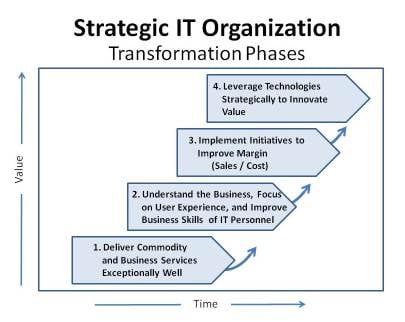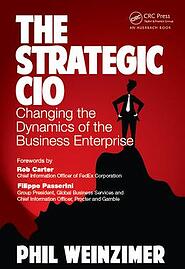
Guest blog by Phil Weinzimer, president of Strategere Consulting and author of a new book, The Strategic CIO: Changing the Dynamics of the Business Enterprise. Mr. Weinzimer speaks regularly on the subject of IT Strategy, and writes for CIO.com.
 There is no better time to be a CIO. Your CEO and C-suite colleagues understand the potential of leveraging information for strategic advantage, and you are in a perfect position to help them accomplish it. But it will require you to transform from a technologist to a strategist. Here's why:
There is no better time to be a CIO. Your CEO and C-suite colleagues understand the potential of leveraging information for strategic advantage, and you are in a perfect position to help them accomplish it. But it will require you to transform from a technologist to a strategist. Here's why:
The consumerization of information technology is revolutionizing how people shop, travel, and pay for services. Information technology is enabling almost every business process that drives customer value. You, as the CIO, need to be more involved in business discussions than ever before.
The CIOs highlighted below—Rob Carter (FedEx), Debra Martucci (Synopsys) Randy Spratt (McKesson), and Filippo Passerini (P&G)— represent four examples of strategic CIOs who, as members of the executive C-suite, develop strategies that enhance customer value, improve margins, and increase shareholder wealth.
Are you and your IT organization up to the challenge?
The Four Phases of Strategic IT Transformation
Over the past few years, I've had the opportunity to speak to over 150 CIOs, IT directors, and business executives who shared their insights and experiences transforming an IT organization into a strategic asset. From these discussions, I uncovered four transformation phases that strategic CIOs navigate to drive measurable business value for their companies.

Phase 1. Deliver Commodity and Business Services Exceptionally Well
Build the trust and confidence of business leaders by understanding their needs and delivering basic services flawlessly.
Rob Carter, CIO at FedEx, recognized an opportunity to improve the delivery of services that support the business processes for the FedEx business units. The problem was a complex infrastructure. He drew what he called an ugly picture of the communication paths and associated infrastructure for all the services. The picture was indeed ugly. It looked like a hundred cobwebs connected where the black lines almost completely covered the white page of a PowerPoint slide. He then met with Fred Smith, Chairman and CEO of FedEx, and showed him the ugly picture. He said, "Fred, I cannot do my job. I will fail unless we fix this". With Fred Smith's approval and the approval of the business unit heads, Carter and his team reengineered the infrastructure. The result, as Carter describes it, "was to enable the business units to compete collectively, manage collaboratively, and operate independently, and provide improved value to its customers."
Phase 2. Improve Business Skills of IT Personnel
Business unit leaders expect IT personnel to exhibit business skills if they wish to engage as part of business teams.
Debra Martucci, CIO at Synopsys, hired MBAs to work with her IT leadership team. She aligned each MBA with a small group of IT personnel to meet once every few weeks. At these sessions, the MBAs coached the IT personnel on the business landscape as well as the competitive environment. They also helped IT personnel understand the business issues that create the need for Synopsys products and services. After a few months, business managers commented how IT personnel were now more involved in business discussions than ever before and were beginning to add real value during meetings.
Phase 3. Implement Initiatives to Improve Margin and Optimize Cost
IT personnel working as part of business teams is the best approach to identify business opportunities that leverage information technology to drive top line growth and optimize cost.
Randy Spratt, CIO and CTO at McKesson, improved the integration process of newly acquired companies because, as McKesson said, "the faster we integrate, the sooner we will derive the economic benefit." McKesson formed a business/IT team to develop an Integration Process Playbook that defined the processes for integrating newly acquired companies. The result was a 75 percent reduction in process time to plan for the integration of newly acquired companies.
Phase 4. Leverage Technology Strategically to Innovate Value
Filippo Passerini, group president, global business services, and CIO at P&G is passionate about creating information democracy across the various business units. His digitize, visualize, and simulate strategy changed the business model to help managers make well-informed business decisions. Passerini created a single-source-of truth database so there was no disagreement over various data sources. His team then developed decision cockpits that displayed key information visibly on desktops to help over 50,000 P&G employees make better decisions quicker. He and his team also developed Business Sphere conference rooms where management groups review analyzed data, using visualization technology, displayed on wall sized monitors that enable them to make well-informed business decisions.
How to Begin Your Strategic CIO Journey 
If you've been thinking seriously about how to help your company leverage information and technology for competitive advantage, I offer the following advice.
- Meet with your C-suite executives and key business unit personnel to share your desire to work together to leverage information and technology for competitive advantage.
- Collaborate with business unit leaders to develop a plan to improve the delivery of business services.
- Assess the strategic skills and maturity of your IT organization, identify and analyze gaps, and develop a transformation plan. (Strategere's free assessment tools can be downloaded here.)
- Collaborate with your business peers to identify opportunities to improve sales and/or reduce costs.
- Work with C-suite to identify new and compelling ways to create unique customer value by leveraging information and technology in innovative ways.
More and more companies now recognize that leveraging information and technology to create unique value based experiences for their customers is the path to success. You, as the CIO, are in a perfect position to enable this success. Buckle up and prepare yourself for a wonderful journey as you transform into a strategic CIO that changes the dynamics of the business enterprise.

Written by Martha Heller
Martha Heller is CEO of Heller and author of Be the Business: CIOs in the New Era of IT, and The CIO Paradox: Battling the Contradictions of IT Leadership.




